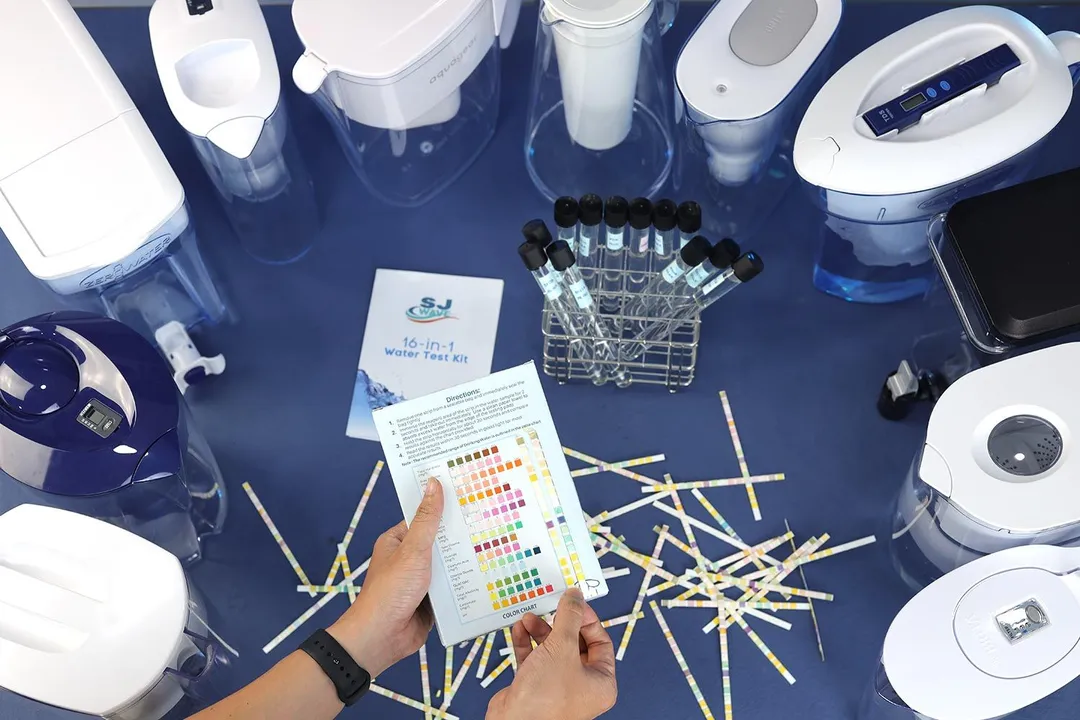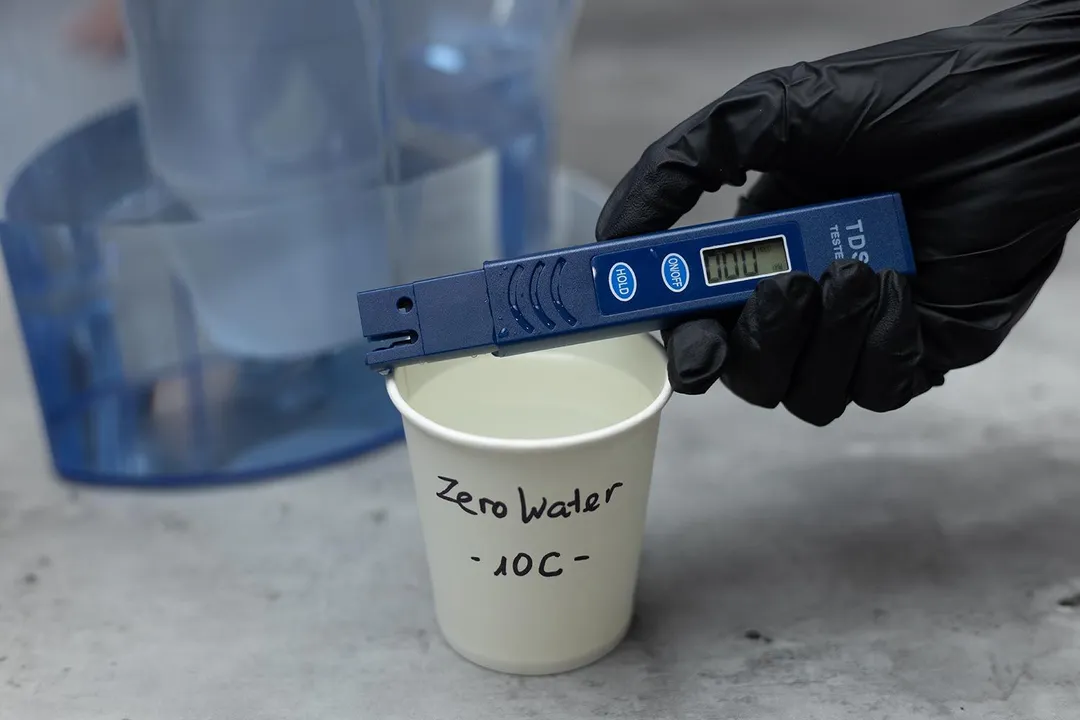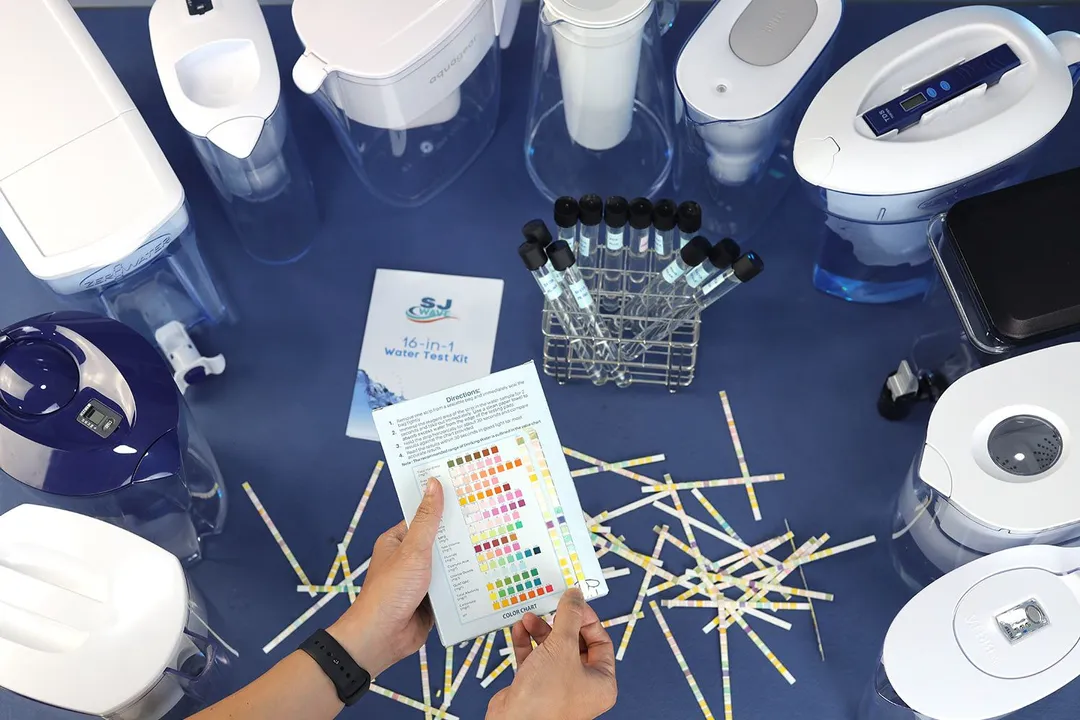Our recommendations are made independently through Research & Testing. We may receive commissions from purchases made via our links.
How We Test Water Filter Pitchers v1.0
We buy and test popular water filter pitchers for filter strength, filter life, filtration rate, and usability to find out the ones most worth buying.
As concerns about water quality continue to rise, individuals and households are increasingly turning to water filter pitchers as a convenient and affordable solution.

With a multitude of water filter pitchers to choose from, proper testing and evaluation is needed more than ever. And, it’s not just about clean water. A pitcher is something you’re likely to use multiple times a day, so good design and usability are important for making the right choice.
Hence, in this feature we shed light on the methodologies and standards used to assess a water filter pitcher’s capabilities, usability, and design. We test for the effective reduction of chlorine levels and analyze the pitcher's flow rate. These, and overall good design and material quality, are important for determining the product lifespan and whether we will recommend the product or not.
Overall Score Weighting
We test and assess water filter pitchers in three main areas: Performance, Usability, and Design. The overall score is a rating on a scale of 1 to 10. Of these, each has a proportionally weighted score:
- Performance: 50%
- Usability: 30%
- Design: 20%
Performance (50%)
We rate the performance of a water filter pitcher by its effectiveness in filtering chlorine, the lifespan of its filter, flow rate, and the water aesthetics post filtration.
Below is a breakdown of the criteria and their score weights:
50% - Chlorine Removal, 30% - Filtration Rate, 10% - Filtered Water Taste & Smell
Chlorine (50%)
Chlorine is a common disinfectant in tap water. Unfortunately, this chemical comes with a distinctive taste and smell that can be off-putting. We run heavily chlorinated water through every filter pitcher and test how effectively it is removed. See details
Flow Rate (40%)
What It Is
How long it takes the pitcher to produce filtered water.
Why It’s Important
A faster flow rate means that the pitcher can filter a larger volume of water more quickly. This is especially useful if you need filtered water quickly or have a high demand household. A high speed is also preferred if you're using the pitcher for cooking or other purposes that require a large volume.
How We Test
We fill each filter pitcher with chlorinated water and record the time it takes to run through the filter.
How We Score
A filter pitcher with a flow rate of 8 - 10 milliliters per second scores 10 points. A flow rate of below 4 milliliters per second receives 1 point, because this means the pitcher takes more than a minute to output one standard glass of filtered water (8 fluid ounces or 237 milliliters).
Flow Rate (ml/s) | Score |
|---|---|
10 | 10 |
9 | 9 |
8 | 8 |
7 | 7 |
6 | 6 |
5 | 5 |
4 | 4 |
3 | 3 |
2 | 2 |
1 | 1 |
Taste & Smell (10%)
What It Is
Whether or not the water has a pleasant taste and smell after being filtered.
Why It’s Important
Most people buy a water filter pitcher with hopes that it will improve the aesthetics of their drinking water. Crisp, clean water can encourage your family and pets to drink more water and stay hydrated.
Because taste and smell are largely subjective, this criterion only has a 10% score weighting.
How We Test
We run tap water through the pitcher and ask three members of the team to assess the taste and smell of the filtered water independently. They then rate the water on a scale of 1 - 10.
How We Score
The final score is the average of the scores given by three testers.
TDS
We measure the TDS (total dissolved solids) reading of the filtered water because this matters to some people for various reasons. However, it is not a scoring factor in our rating because TDS is not a reliable criterion when determining water safety.

According to the EPA, an elevated TDS level does not necessarily mean that the water is toxic or undrinkable. It could in fact indicate that the water actually contains beneficial minerals or other compounds. On the other hand, the water could be contaminated with hazardous materials and still have lower TDS values.
Usability (30%)
Most people will use a water filter pitcher a number of times throughout the day. As such, it is important to gauge how easy it is to grip, hold, and pour. Assembly and maintenance is equally important for enjoyable and continued use.
Here are the criteria we use to evaluate the usability of a water filter pitcher and the respective score weightings:
Here are the criteria we use to evaluate the usability of a water filter pitcher and their respective score weights.
- 20% - Assembling
- 30% - Refilling
- 40% - Dispensing
- 10% - Cleaning
Assembling (20%)
We assemble and disassemble the upper reservoir and the filter several times since this is the standard operation for cleaning or replacing parts. Some pitchers have an intuitive design with grippy parts that are easy to work with, while others require excessive force. We also note if any parts seem fragile or prone to damage during this process.
Refilling (30%)
We check how easy it is to fill the pitcher to maximum capacity and whether there’s leaking or splashing during refilling. We also record the number of refills it takes for the lower reservoir to reach the full capacity.
Factors we consider include:
Scoring Table for Refilling
Criteria | Score |
|---|---|
Refill mechanism (lid, spout, handle) and viability of single-handed refilling. | 5 |
Whether the lower reservoir part can be emptied completely. | 3 |
A reservoir:pitcher capacity ratio that’s close to 1 (>=0.7). | 2 |
Total | 10 |
Dispensing (40%)
An important usability aspect is whether you can pour filtered water from the lower reservoir while the upper chamber is still filtering water. We also note the sturdiness of the lid and spout and if water leaks during pouring. Since it is more desirable if all water can be emptied from the pitcher, we test to see if this is possible.
Scoring Table for Dispensing
Criteria | Score |
|---|---|
Ease of pouring filtered water with the filter tray 1/3 full | 3 |
Sturdy lid while pouring | 4 |
Anti-splash spout/spigot that’s easy to use | 2 |
Ability to completely empty the pitcher | 1 |
Total | 10 |
Cleaning (10%)
We check the external body and gauge whether the pitcher is prone to collecting dust, dirt, or fingerprints. We clean the filter pitcher by hand and check edges or grooves that are tricky to reach.
A pitcher gets extra points if it’s dishwashable.
Design (20%)
A well-designed pitcher should last a long time and function efficiently throughout its lifespan. A pitcher should likewise be intuitive, easy to use, and visually appealing to enhance the overall user experience.
We assess the design of a water filter pitcher using three criteria:
- 30% - Build Quality
- 20% - Conveniences
- 50% - Filter Piece
Build Quality (30%)
Material quality and design are great indicators of the durability of a water filter pitcher. Most pitchers are made of some kind of convenient light-weight plastic; however, they differ a lot in terms of thickness, durability, and aesthetics. While we give better scores to products that are BPA-free, this is not a major factor since pitchers are meant for tap water and not hot water.
Fit and finish are equally important. Pitchers scoring high in fit and finish look attractive on your counter, dining table, or in other areas and this can motivate people to drink water more often.
Scoring Table for Build Quality
Criteria | Score |
|---|---|
Strong handle(s) with a firm grip | 3 |
Catchy design and a sleek finish | 3 |
Thickness and robustness | 2 |
BPA free materials | 1 |
Tight and secure fit of cover and upper tray | 1 |
Total | 10 |
Conveniences (20%)
Small conveniences can make a big difference in a water pitcher and improve the practicality and usage of the product. These minor features can add to convenience and make the pitcher look more attractive on your countertop.
Here’s a breakdown of our scoring criteria:
Scoring Table for Conveniences
Criteria | Score |
|---|---|
Ergonomics: Is it stable and can it fit in a fridge door? | 4 |
Replacement indicator: Is it reliable? | 3 |
Others: Is there a spigot, anti-splash spout, filling trap door or more? | 3 |
Total | 10 |
Filter & Filter Case (50%)
The filter is arguably the most important part of the pitcher. A well-designed filter should not only remove contaminants effectively, but also be sturdy and easy to install and remove.
When assessing the design of the filter, we also test to see if it leaks filtration materials— such as activated carbon— into the water. Another factor is whether the filter actually filters the water and if it clogs before needing to be replaced.
Filter Scoring Table
Criteria | Score |
|---|---|
Sturdy, easy to assemble/disassemble | 3 |
Well sealed, doesn’t leak materials | 4 |
Does not clog or let unprocessed water through | 3 |
Has a good filter life: 1 month - 0.5 pt., 2 months - 1pt, 3 months - 2 pt., 4 months - 3 pt., 5 months - 4pt | 0 |
Total | 10 |
Test Developers
Anh Ngo is a writer with 9 years experience at different media outlets, covering from public news and events to product testing and analysis. At HealthyKitchen101, she works across different departments, communicating closely with its network of writers, editors, and health, tech, and search engine experts to provide a meaningful and pleasant reading experience for visitors.
Lap is Head of the Research, Testing, and Review Team (RTR Team) at HealthyKitchen101.com, where he directs and supervises the testing of kitchen gadgets and appliances.
Nguyen Ntk is a graphic designer, photographer, and videographer whose philosophy centers around respecting and celebrating the beauty of reality. Through his lenses, Nguyen strives to capture the true essence of objects and events, showcasing and highlighting authentic features without distortion or exaggeration.



